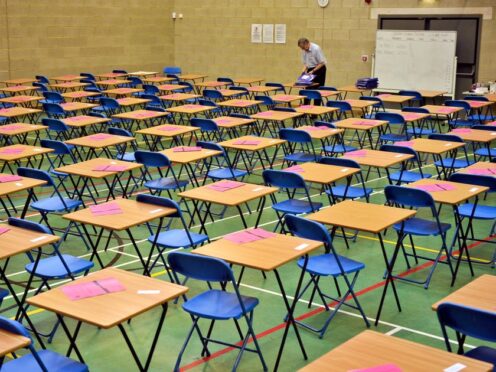
Minority ethnic artists and their work are significantly under-represented in the school curriculum, a report has suggested.
Only 2.3% of all named stand-alone artists referenced in GCSE art and design exam papers are from black or South Asian backgrounds, according to the race equality think tank Runnymede Trust and charity Freelands Foundation.
The analysis – which looked at the art and artists referenced in GCSE assessment materials from four exam boards across three years – found “shocking levels of under-representation”.
Work by minority ethnic artists represents only 10.8% of mentions in exam papers, while work by white artists represents 89.2%, the research found.
The report said: “The level of representation offered by the exam board assessment materials is woefully inadequate and sets poor expectations for what teachers should be teaching in the art classroom.”
There have been calls to decolonise and diversify the curriculum in schools for some time.
Participation levels of minority ethnic students studying art and design have been increasing in recent years, but the study concluded that art education in schools “remains overwhelmingly narrow in terms of both curriculum content and exam assessment”.
The research analysed 27 GCSE art and design exam papers from exam boards AQA, Edexcel, OCR and Eduqas over three years between 2018 and 2023.
The years 2020, 2021 and 2022 were omitted from the data as the exam series was affected by the Covid-19 pandemic.
Of 975 references to named contemporary artists, there were just 17 references to named contemporary black artists – which included Ghanaian sculptor El Anatsui and Kenyan-born potter Dame Magdalene Odundo.
There were only 11 mentions of a contemporary South Asian artist – and three of these referred to the British Indian sculptor Anish Kapoor.
The report concluded: “Exam boards play a critical role in shaping curriculum expectations and content, and the research reveals that they are currently architects of a woefully inadequate system.
“Not only is there poor representation referencing black and South Asian artists, but where work by minority ethnic artists is referred to it is often in secondary and subordinate ways.
“It often appears in generalised geographical and movement-based references, and is associated with pre-1800 time periods.”
The report has called on exam boards to ensure that GCSE exam papers include a minimum of 25% minority ethnic artists to “reflect the growing diversity of the school-aged population” in England and Wales.
The Department for Education (DfE) should also publish clear annual data on teacher demographics, student participation rates and attainment outcomes, disaggregated by ethnic background, to “understand the exact situation regarding race and inclusion in art education”, the report said.
Dr Shabna Begum, interim chief executive of the Runnymede Trust, said: “The astonishing lack of diversity across art education isn’t the result of disinterest from students or their teachers.
“To the contrary – students are eager to use their art classrooms as sites for meaningful conversations about race, identity and anti-racism, while teachers are crying out for help to diversify their teaching content to meet their students’ needs.”
She added: “It’s up to exam boards, policymakers, and the broader visual arts sector to now work together to build an art education that students enjoy learning and teachers want to teach.
“An ambitious, enriching, broad and inclusive curriculum should be something everyone can work together for.”
Dr Henry Ward, director of the Freelands Foundation, said: “Contemporary artists come from, and represent, an increasingly diverse society and we must all play our part to ensure that art education reflects this, in both the resources we share and the people that participate.”
Hayley White, vice president for assessment at Pearson – which runs exam board Edexcel, said: “We have a long-standing commitment to a diverse, inclusive and representative curriculum and assessments.
“Our Art and Design A-level externally set assignment for 2024 features more than 25% minority ethnic artists, and we look forward to extending this to GCSE Art and Design from 2025 too.”
A spokesperson for Eduqas, which has also committed to a minimum 25% target of minority ethnic artists representation in their exam papers by 2025, said: “We will work with subject experts and consultants to ensure that the material we introduce will reflect learners’ cultural heritage and lives.”
Jill Duffy, chief executive of OCR, said: “We are committed to making our assessments inclusive and accessible and will use the findings in our work focused on minority ethnic representation in the curriculum. It’s vital that all students see themselves in what they study at school.”
An AQA spokesperson said: “We have a well-developed programme of work to improve our assessments to make them more representative of the world we live in.
“We’ve specifically made some recent and significant additions to our GCSE art and design papers, and at A-level many of our papers already exceed 25% minority ethnic artists.”
A Department for Education (DfE) spokesperson said: “Knowledge-rich teaching includes diversity as a natural part of understanding a subject. Exam bodies decide the detailed content for their GCSE art and design qualification, such as breadth and diversity of artists and movements in art and design.
“The qualification must meet the department’s subject content requirements, including knowledge and understanding of art, craft and design in historical and contemporary contexts, societies and cultures.”

Enjoy the convenience of having The Sunday Post delivered as a digital ePaper straight to your smartphone, tablet or computer.
Subscribe for only £5.49 a month and enjoy all the benefits of the printed paper as a digital replica.
Subscribe